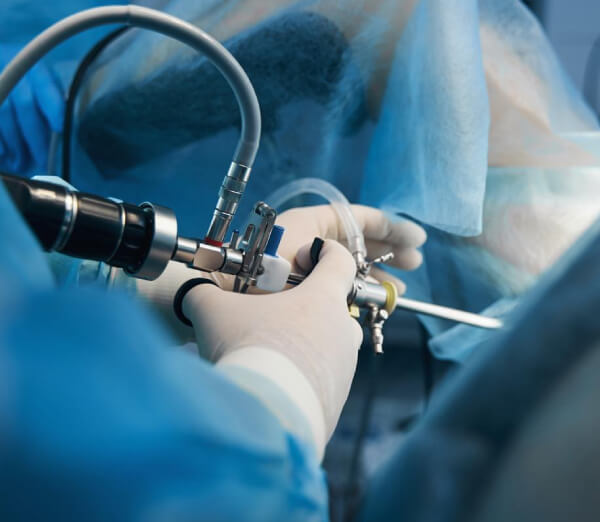
Hysteroscopy Procedure for Fertility Treatment
The Hysteroscopy procedure involves the insertion of a tubal instrument called a “Hysteroscope” into the uterus through the vagina or cervical tract. This allows the healthcare provider to visually examine the interior of the uterus, cervix, and vagina. The purpose of this examination is to identify any abnormalities such as fibroids, adhesions, or polyps that might be responsible for symptoms like bleeding and abdominal pain. In addition to diagnosis, a doctor can also use this procedure to address and treat any issues discovered during the examination.
What is hysteroscopy?
Hysteroscopy is a procedure in which a telescope is inserted through the abdomen into the uterus to visualize the internal organs. It serves as a diagnostic tool to identify various conditions. Additionally, hysteroscopy can also be employed for treatment purposes, aiming to address existing issues and prevent potential problems from arising in the future.
Two types of hysteroscopy are also available:
- Diagnostic hysteroscopy: Diagnostic hysteroscopy is employed to identify and diagnose issues or abnormalities within the uterus. It serves as a valuable tool, especially following other fertility examinations such as HSG, laparoscopy, or X-rays, by providing further insights into the uterine condition.
- Operative hysteroscopy: Operative hysteroscopy involves using the hysteroscopy procedure to address and treat problems that have been identified either through diagnostic hysteroscopy or other diagnostic tests. This can be performed concurrently with diagnostic hysteroscopy, saving time and avoiding the need for an additional surgical procedure.
Why hysteroscopy procedure is done?
A surgeon can correct the following conditions through hysteroscopy.
- Hysteroscopy for diagnosis and treatment: Hysteroscopy serves as a valuable tool for both diagnosing and treating various uterine conditions. It is an integral part of infertility treatment and can effectively address minor anatomical issues within the uterus. It plays a significant role in the removal of fibroids, polyps, and other anatomical defects.
- Removal of fibroids and polyps: Fibroids or polyps that have grown excessively large can lead to recurrent infertility and pregnancy loss. Hysteroscopy is a suitable approach for removing these abnormal growths from the uterus, thereby addressing the associated fertility issues.
- Detection and removal of uterine adhesions: Uterine scar tissue, known as adhesions, can cause infertility and excessive menstrual flow. Hysteroscopy enables the identification and removal of these adhesions, helping to restore normal uterine function and potentially improving fertility outcomes.
- Septum removal: In cases where a woman has a septate uterus, which increases the risk of miscarriage, hysteroscopy can be used to remove the uterine septum. By eliminating this anatomical anomaly, the chances of successful pregnancy can be improved.
- Management of abnormal bleeding: Hysteroscopy is a valuable diagnostic tool when investigating severe or irregular bleeding between periods. During the procedure, any areas causing the abnormal bleeding can be identified, and appropriate treatment methods such as laser, electrocautery, or surgical techniques can be employed to address the specific bleeding areas discovered.
What is the procedure of hysteroscopy?
Hysteroscopy can only be performed by a skilled team of medical professionals while the patient is under general anesthesia.
Our team of IVF experts will provide guidance regarding dietary recommendations, suggesting light meals the day before the hysteroscopy procedure. The type of anesthesia, either general or local, will be determined based on the specific circumstances and needs of the patient.
Upon arrival at the operating room, the doctor will instruct you to lie down on the table. The positioning will be similar to that of a routine gynecological examination, with your feet placed in the stirrups on the table. This positioning allows for optimal access and visualization during the hysteroscopy procedure.
Hysteroscopy procedure
Certainly! Here are the key points regarding the hysteroscopy procedure:
- Patient positioning: Lie down on a couch with leg supports; lower body covered with a sheet.
- Speculum insertion (optional): A speculum may be inserted into the cervix to keep it open, similar to cervical screening.
- Antiseptic solution: Clean the cervix and vaginal areas with an antiseptic solution.
- Hysteroscope introduction: A hysteroscope, a thin tube with a light and camera, is passed through the cervix.
- Possible discomfort: Cramping or discomfort may be experienced during hysteroscope insertion.
- Fluid injection: Fluid is delicately injected into the uterus to improve visualization.
- Image transmission: The camera sends images to a monitor for examination by the specialist nurse or doctor.
- Detection of abnormalities: Abnormalities or irregularities can be identified through hysteroscopy.
These points summarize the key steps and aspects of the hysteroscopy procedure.
Hysteroscopy and IVF
Hysteroscopy is a valuable diagnostic tool utilized by our IVF specialists to evaluate patients experiencing infertility. It is an integral part of the IVF process as it allows us to assess the health of your uterus and sperm, ensuring optimal conditions for successful embryo implantation.
During the hysteroscopy, our fertility specialist will carefully examine your reproductive system to identify any potential issues that may be contributing to infertility. This thorough evaluation enables us to provide tailored fertility treatment options suited to your specific needs.
In certain cases, if large fibroids are detected during hysteroscopy, your doctor may recommend a brief waiting period before initiating an IVF cycle. This allows time for appropriate management of the fibroids before proceeding with the fertility treatment.
Our dedicated team of specialists is committed to guiding you through the diagnostic process, understanding your fertility concerns, and devising the most suitable treatment plan to enhance your chances of achieving pregnancy.
What are the advantages of the hysteroscopy procedure?
Hysteroscopy enables surgeons to both diagnose and treat various conditions in a single operation, offering the advantages of precise and minimally invasive surgery. This procedure allows surgeons to identify abnormalities with accuracy and perform targeted interventions, all while minimizing the risk of damage to surrounding tissue. By utilizing hysteroscopy, surgeons can effectively diagnose and address specific issues, leading to improved patient outcomes and a reduced impact on the surrounding anatomical structures.
What risk can be associated with hysteroscopy?
Like any medical procedure, hysteroscopy carries potential risks and complications.
- Anesthesia-related issues: There is a small risk of complications associated with anesthesia administration during hysteroscopy.
- Infection: Although uncommon, there is a possibility of developing an infection following the procedure. It is important to take necessary precautions to minimize the risk of infection.
- Cervical damage: While rare, there have been instances of cervical damage or tears during hysteroscopy. This occurrence is not common, but it is essential to be aware of the potential risk.
- Issues with gas or fluid: Some patients may experience problems related to the use of gas or fluid in the uterus during hysteroscopy. This can include discomfort or bloating.
- Organ damage: In rare cases, nearby organs such as the ovaries, bowel, or bladder could sustain damage during the procedure. The risk of organ damage is typically low but needs to be considered.
If you experience any concerning symptoms such as fever, severe abdominal discomfort, or heavy bleeding following the hysteroscopy, it is crucial to contact your doctor immediately. Prompt medical attention can help address any potential complications and ensure appropriate follow-up care.
What are the complications of hysteroscopy?
Although complications associated with hysteroscopy are infrequent, it is important to be aware of potential risks. Some complications that can arise include:
- Anesthetic reaction: In rare cases, a reaction may occur in response to the liquid used to clean the uterus during hysteroscopy.
- Heavy bleeding: There is a possibility of experiencing heavy bleeding following the procedure, although this is uncommon.
- Pulmonary edema: Pulmonary edema, which involves the accumulation of fluid in the lungs, is a rare complication that can occur during hysteroscopy.
- Uterine perforation: In rare instances, the uterus may be perforated during the procedure, causing a small tear or hole.
- Uterine injury: Although rare, there is a potential risk of injury to the uterus during hysteroscopy.
- Scarring of uterine tissues: During operative hysteroscopy, there is a slight risk of scarring occurring in the uterine tissues.
- Infection: While uncommon, there is a small chance of developing an infection in the uterus or vagina as a result of the hysteroscopy procedure.
How much does hysteroscopy cost in India?
The cost of hysteroscopy in India can vary depending on the type and level of care received, ranging from INR 5,000 to INR 50,000. It is worth noting that some insurance policies may cover the cost of hysteroscopy, so it is advisable to check your coverage.
Your surgeon may recommend hysteroscopy for various reasons, particularly in cases of infertility where a thorough examination of the uterus and potential minor surgical interventions are necessary.
Hysteroscopy is generally considered a low-risk procedure, and the recovery time is typically fast. Most individuals can resume their daily activities within two days after the procedure. In some cases, undergoing hysteroscopy before attempting in vitro fertilization (IVF) can help prevent potential failed IVF attempts. This increases the chances of achieving natural conception as well as a successful outcome with IVF.
Why Choose Us?
We Receive the Best Patient’s Review.

Adeola Ogunjimi

Jessica Wong

Babatunde Okeke

Damilola Ajayi

Funmilayo Akinwande
Blogs on Infertility, IVF, IUI and More
Valuable advice and informative articles on lifestyle, fertility, and infertility for both men and women.
Get a FREE Consultation From Our Fertility Experts Today!






